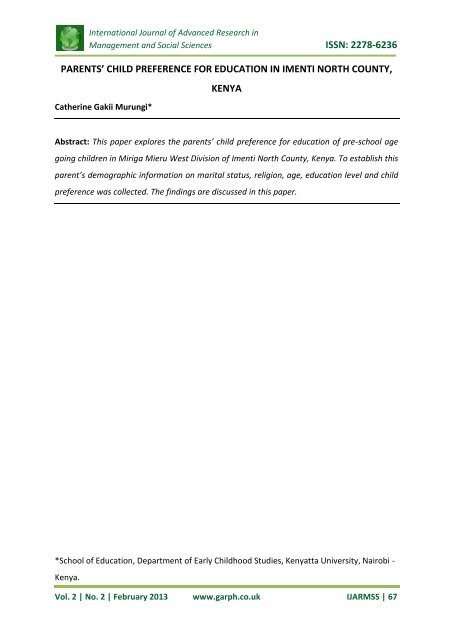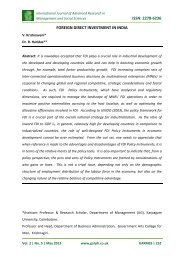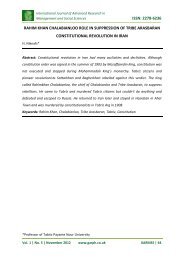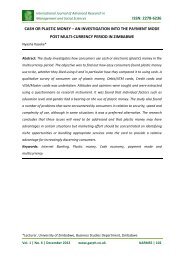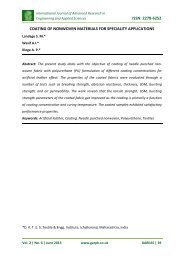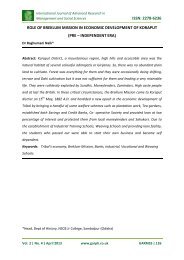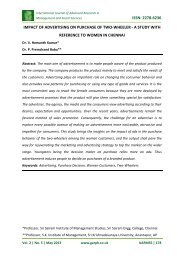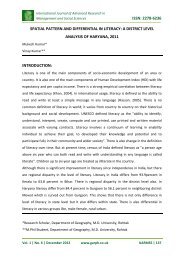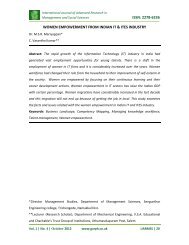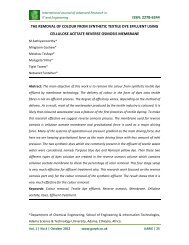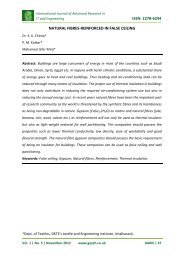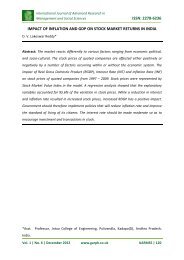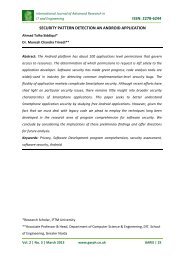issn: 2278-6236 parents' child preference for ... - Garph.co.uk
issn: 2278-6236 parents' child preference for ... - Garph.co.uk
issn: 2278-6236 parents' child preference for ... - Garph.co.uk
You also want an ePaper? Increase the reach of your titles
YUMPU automatically turns print PDFs into web optimized ePapers that Google loves.
International Journal of Advanced Research in<br />
Management and Social Sciences ISSN: <strong>2278</strong>-<strong>6236</strong><br />
PARENTS’ CHILD PREFERENCE FOR EDUCATION IN IMENTI NORTH COUNTY,<br />
Catherine Gakii Murungi*<br />
KENYA<br />
Abstract: This paper explores the parents’ <strong>child</strong> <strong>preference</strong> <strong>for</strong> education of pre-school age<br />
going <strong>child</strong>ren in Miriga Mieru West Division of Imenti North County, Kenya. To establish this<br />
parent’s demographic in<strong>for</strong>mation on marital status, religion, age, education level and <strong>child</strong><br />
<strong>preference</strong> was <strong>co</strong>llected. The findings are discussed in this paper.<br />
*School of Education, Department of Early Childhood Studies, Kenyatta University, Nairobi -<br />
Kenya.<br />
Vol. 2 | No. 2 | February 2013 www.garph.<strong>co</strong>.<strong>uk</strong> IJARMSS | 67
International Journal of Advanced Research in<br />
Management and Social Sciences ISSN: <strong>2278</strong>-<strong>6236</strong><br />
BACK GROUND<br />
Contemporary household is characterized by each parent’s utility function, which is shaped<br />
by their own <strong>preference</strong>s (Vermeulan 2002). This means in this paper that, when finances<br />
are <strong>co</strong>nstrained or are not enough the decision on whether the little available is spent on<br />
educating <strong>child</strong>ren or not depends on a parents <strong>preference</strong> also whether to use the<br />
resources in educating a male or a female <strong>child</strong>. Consequently, <strong>preference</strong>s have a large<br />
impact on the well-being of <strong>child</strong>ren. Resources invested in a <strong>child</strong> are determined not only<br />
by the level of resources available, but also by a parent’s <strong>preference</strong>s (Vermeulan 2002).<br />
Preferences between parents need not be the same; there<strong>for</strong>e out<strong>co</strong>mes of mothers’ and<br />
fathers’ actions can differ (Brown & Park 2002). While this can benefit the <strong>child</strong>ren, Children<br />
from the Meru <strong>co</strong>mmunity may not have this benefit, gender of the parents was not<br />
<strong>co</strong>nsidered since almost exclusively young <strong>child</strong>ren especially in the pre-school years are<br />
associated with mothers, fathers associate themselves with <strong>child</strong>ren when they are all<br />
grown up, even though this is the case there were men parents who participated in this<br />
study.<br />
To exercise <strong>preference</strong>s, a parent must have the ability to do so (Rubalcava, Teruel &<br />
Thomas 2004). The work by Haddad & Hoddinott in 1994, suggests that bargaining power<br />
over household e<strong>co</strong>nomic decisions, especially when held by women, is associated with<br />
improved well-being <strong>for</strong> herself and her <strong>child</strong>ren than when the same resources are in the<br />
hands of men (Haddad & Hoddinott 1994; Rubalcava, Teruel & Thomas 2004). This<br />
necessitates the current study and more so since majority of the sample <strong>co</strong>mprises women.<br />
To<br />
further understand parental <strong>preference</strong>s in Imenti North County, an examination of<br />
parents demographic data was necessary to understand their types of power structures, and<br />
their believe system in relation to particularly educating <strong>child</strong>ren at pre-school level and in<br />
<strong>co</strong>nsequently in the other levels of education . To figure this out there was need to <strong>for</strong> this<br />
paper to find out and establish these parents marital status, religion, age, education level<br />
and <strong>child</strong> <strong>preference</strong><br />
Recent research provides an important insight that while the existing research has focused<br />
on understanding the role of parental background on skills and <strong>preference</strong>s that facilitate<br />
individual success ( Flavio Cunha and Heckman 2007; Cunha et al.2006; Heckman 2006).<br />
Also a study by Michal, Julie & Barbara (2011), noted that while the existing research has<br />
Vol. 2 | No. 2 | February 2013 www.garph.<strong>co</strong>.<strong>uk</strong> IJARMSS | 68
International Journal of Advanced Research in<br />
Management and Social Sciences ISSN: <strong>2278</strong>-<strong>6236</strong><br />
focused on understanding the role of parental background and on skills and <strong>preference</strong>s<br />
that facilitate individual success no work has focused on parental <strong>preference</strong>s and in<br />
particular in education <strong>for</strong> <strong>child</strong>ren in relation to school enrolments. This paper focuses on<br />
parental <strong>child</strong>’s <strong>preference</strong> <strong>for</strong> education.<br />
METHODS<br />
This study was a descriptive study employing a survey method. The study was <strong>co</strong>nducted in<br />
Imenti North County which was <strong>for</strong>merly called Meru central District. The District is<br />
approximately 1,141 square kilometres in size with 54,777 households with pre-school age<br />
<strong>child</strong>ren of 4-5 years. Imenti North District has a population of 243,220 pre-school age<br />
<strong>child</strong>ren of 4-5 years. The study targeted parents of pre-school age going <strong>child</strong>ren. Ac<strong>co</strong>rding<br />
to the census report by Central Bureau of Statistics (CBS) of 1999, Miriga Mieru West<br />
Division of Imenti North County has got five locations identified and documented. These are<br />
Ntima with a population of 10,431 <strong>child</strong>ren of 4-5 years, Municipality with 27,349 <strong>child</strong>ren<br />
of 4-5 years, Igoki with 8,555 <strong>child</strong>ren, Ntankira with 19,554 and Nthimbiri with 12,312. The<br />
five locations of Miriga Mieru West Division of Imenti North District have a total population<br />
of 78,201 pre-school <strong>child</strong>ren aged 4-5 years. From the target population of parents with<br />
<strong>child</strong>ren of pre-school age a probability sample size of 390 parents was selected.The study<br />
utilized the questionnaire <strong>for</strong> parents in data <strong>co</strong>llection.<br />
RESULTS AND DISCUSSIONS<br />
Parents’ Marital Status<br />
To establish the marital status of parents, they were asked to state whether they are single,<br />
married, divorced, separated or widowed. Out of the 390 parents who participated in the<br />
study in the five locations 288, (74%) of them were married, 44 (11%) were single, 32 (8%)<br />
of them were separated, 20 of them were widowed and less than one percent of these<br />
parents were divorced.<br />
Parents’ Religion<br />
To establish the religion of parents, they were asked to tick their religion. Whether Catholic,<br />
Protestant, Muslim or specify any other religion. After this, it was evident that parents who<br />
participated in the study belonged to a certain religion of which majority 282 (72%) were<br />
Protestants, 85 parents (22%) were Catholics, Muslims and other religions ac<strong>co</strong>unted <strong>for</strong><br />
4%. Among these 15 parents were Muslims and 8 parents belonged to other religions.<br />
Vol. 2 | No. 2 | February 2013 www.garph.<strong>co</strong>.<strong>uk</strong> IJARMSS | 69
International Journal of Advanced Research in<br />
Management and Social Sciences ISSN: <strong>2278</strong>-<strong>6236</strong><br />
Religion is important not only to parents but also to young <strong>child</strong>ren since it inculcates in<br />
them moral values such as right and wrong, it also develops a firm foundation of faith to be<br />
built upon as they get older. Religious practices can also determine <strong>child</strong> rearing practices.<br />
Parents’ Age<br />
To establish the age of parents, they were asked to indicate the category that best explained<br />
their age. A large number of parents in the study 203 (52%) were between 25 – 34 years of<br />
age while only 13parents (3%) were above the age of 55 years. Parents between the age<br />
brackets 35 – 44 years were 94 (24%), those between ages 18-24 years were 58 (15%) and<br />
ages 45 - 54 years were 22 (6%).<br />
Parents’ Education Level<br />
To establish parents’ levels of education, they were asked to state their highest level of<br />
education <strong>co</strong>mpleted and their responses are indicated in table 1<br />
Table 1: Parent’s Level of Education by Location<br />
Location<br />
Parents Education Level Igoki Municip<br />
al<br />
Primary Frequency 15 12<br />
Ntankira<br />
24<br />
Nthimbir<br />
i<br />
25<br />
Ntima<br />
26<br />
Total<br />
102<br />
Percentages (%)<br />
Se<strong>co</strong>ndary Frequency<br />
(19.2)<br />
22<br />
(15.4)<br />
17<br />
(30.8)<br />
13<br />
(32.1)<br />
19<br />
(33.3)<br />
18<br />
(26.1)<br />
89<br />
Percentages (%)<br />
(28.2)<br />
(21.8)<br />
(16.7)<br />
(24.4)<br />
(23.1)<br />
(22.8)<br />
Post sec/ College/<br />
Professional training<br />
Frequency<br />
16<br />
10<br />
4<br />
11<br />
4<br />
45<br />
Percentages (%)<br />
University<br />
Frequency<br />
(20.5)<br />
3<br />
(12.8)<br />
1<br />
(5.1)<br />
1<br />
(14.1)<br />
1<br />
(5.1)<br />
0<br />
(11.5)<br />
6<br />
Percentages (%)<br />
No schooling<br />
Frequency<br />
(3.8)<br />
22<br />
(1.3)<br />
38<br />
(1.3)<br />
36<br />
(1.3)<br />
22<br />
(0.00)<br />
30<br />
(1.5)<br />
148<br />
Percentages (%)<br />
Total Frequency<br />
(28.2)<br />
78<br />
(48.7)<br />
78<br />
(46.1)<br />
78<br />
(28.2)<br />
78<br />
(38.4)<br />
78<br />
(37.9)<br />
390<br />
Percentages (%)<br />
(100)<br />
(100)<br />
(100)<br />
(100)<br />
(100)<br />
(100)<br />
Vol. 2 | No. 2 | February 2013 www.garph.<strong>co</strong>.<strong>uk</strong> IJARMSS | 70
International Journal of Advanced Research in<br />
Management and Social Sciences ISSN: <strong>2278</strong>-<strong>6236</strong><br />
Table 1 shows that 102 parents (26%) had a primary school education while only 6 parents<br />
(2%) had a university education. The study also found that 148 parents (38%) did not have<br />
an education at all. Among the 390 parents, 89 (23%) of them had a se<strong>co</strong>ndary education<br />
and only 45 parents (12%) had gone to <strong>co</strong>lleges and other professional training institutions.<br />
Interestingly, Ntima and Ntankira locations had the least number of parents with post<br />
se<strong>co</strong>ndary education. In the five divisions the number of parents with post-se<strong>co</strong>ndary<br />
education decreased as indicated in table 1. It was necessary to establish the education<br />
level of parents since it has been strongly associated with health of <strong>child</strong>ren and also the<br />
importance attached to education. Research indicates that highly educated parents seek<br />
medical advice (Gering et al., 2006).<br />
PARENTS’ CHILD PREFERENCE FOR EDUCATION<br />
Parents were asked if they did not have enough money, which of the <strong>child</strong>ren they would<br />
prefer to educate between boys or girls. It came out that parents in Imenti North County,<br />
Kenya prefer to educate both boys and girls. Some parents 186 (48%) preferred to educate<br />
girls and 204 parents (52%) preferred to educate the boys. Some of the reasons given by<br />
parents <strong>for</strong> making their choice to educate the girls and not boys were that girls have more<br />
needs than boys, and are able to help themselves as well as others when educated. Parents<br />
also reported that girls are more merciful to them than boys, that girls are more<br />
development <strong>co</strong>nscious and more responsible, they are less problematic and more<br />
vulnerable, these parents argued that boys get inheritance from parents or grandparents<br />
but girls can get married to a family with nothing and suffer more raising <strong>child</strong>ren and taking<br />
care of the family, but if she gets a good education, she can be a pillar to support her family<br />
<strong>co</strong>m<strong>for</strong>tably. These parents also argued that boys can get many casual jobs to do than girls.<br />
Parents who supported girl education gave examples of what girls have done in their villages<br />
like <strong>co</strong>nstructing permanent houses <strong>for</strong> their parents, helping the needy <strong>child</strong>ren in the<br />
<strong>co</strong>mmunity and cited the fact that girls can now be<strong>co</strong>me national leaders and take powerful<br />
positions in government.<br />
Parents who preferred educating boys than girls said that it is better to educate a boy<br />
because a girl can be<strong>co</strong>me pregnant and drop out of school hence the enormous resources<br />
put to her education ends up being wasted. The same parents argued that a boy needs<br />
education to be responsible since they are expected to marry and take good care of their<br />
Vol. 2 | No. 2 | February 2013 www.garph.<strong>co</strong>.<strong>uk</strong> IJARMSS | 71
International Journal of Advanced Research in<br />
Management and Social Sciences ISSN: <strong>2278</strong>-<strong>6236</strong><br />
families. The opinions of parents who preferred educating girls and those who preferred<br />
educating boys strongly bring out the idea that both the boy-<strong>child</strong> and the girl-<strong>child</strong> need<br />
education to have a better future, get employed or start a business to help themselves and<br />
their families.<br />
The views of these parents on <strong>child</strong> <strong>preference</strong> are <strong>co</strong>nsistent with those of participants in a<br />
study by Ncabira (2005) who found that parents in Meru Central County viewed educating<br />
boys to be more crucial given the ultimate roles as family heads and bread winners. They<br />
also believed that boys are more intelligent than the girls and that girls are less successoriented<br />
than boys. Given the perceptions of parents in the two studies, it is not surprising<br />
to find girls who have dropped out of school due to family inability to meet their financial<br />
demands of schooling, or being used as a source of in<strong>co</strong>me <strong>for</strong> the household.<br />
A study by David & Amy, (1974) on individual sessions with 150 preschool <strong>child</strong>ren aged two<br />
through four: they were asked to choose which parent (in the next room) they wanted to<br />
participate with them in each of seven play activities. The purpose was to investigate<br />
hypotheses about parent <strong>preference</strong> in a theory of sex-role and parental identification. Boys<br />
showed a strong father <strong>preference</strong> (p
International Journal of Advanced Research in<br />
Management and Social Sciences ISSN: <strong>2278</strong>-<strong>6236</strong><br />
4. Haddad, L., & Hoddinott, J. (1994). Women's in<strong>co</strong>me and boy-girl anthropometric<br />
status in the Cote d'Ivoire. World Development, 22(4), 543-53.<br />
5. Rubalcava, L., Teruel, G., & Thomas, D. (2004). Spending, Saving and Public Transfers<br />
Paid to Women. Cali<strong>for</strong>nia Center <strong>for</strong> Population Research. On-Line Working Paper<br />
Series. Retrieved on May 5, 2012 from http://repositories.cdlib.org/.<br />
6. Michal, B., Julie, C., Barbara, P., (2011), Effects of Parental Background on Other-<br />
Regarding Preferences in Children, IZA DP No. 6026 retrieved on May 5 th 2012 from<br />
www.aeaweb.org/aea/2012<strong>co</strong>nference/program/retrieve<br />
Vol. 2 | No. 2 | February 2013 www.garph.<strong>co</strong>.<strong>uk</strong> IJARMSS | 73


